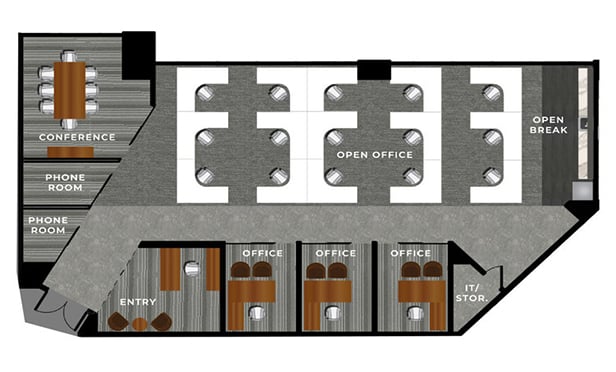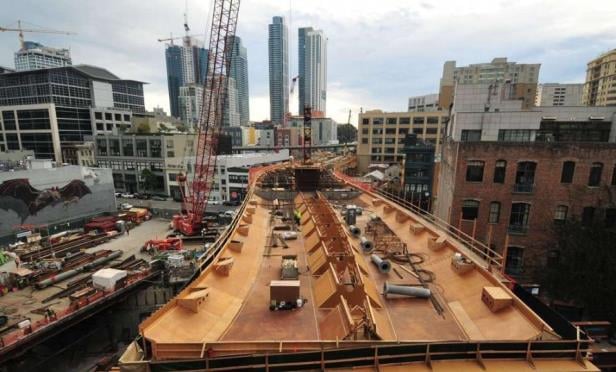
WASHINGTON, DC—The topline construction numbers issued Monday point to a rebound in August after a July decline that was revised further downward with the release of the August figures. It's where the spending didn't occur that's worrisome, says the Associated General Contractors of America.
“It is encouraging that spending rebounded in August for many types of residential, private nonresidential and public projects,” says Ken Simonson, chief economist with AGC. “However, the August numbers also show that public and private nonresidential construction are continuing to slow or fall below last year's levels. Spending patterns are likely to be uneven through next year, as previously hot categories cool off but others revive.”
The Census Bureau said Monday that construction spending during August 2017 was estimated at a seasonally adjusted annual rate of $1,218.3 billion, 0.5% percent above the revised July estimate of $1,212.3 billion. In turn, the August figure is up 2.5% from the August 2016 estimate of $1,189.1 billion. During the first eight months of this year, construction spending amounted to $806.2 billion, up 4.7% from the $769.9 billion for the year-ago period.
Simonson notes that although all major categories had gains for the month, private nonresidential and public construction totals were lower than a year ago, while single- and multifamily construction both rose on a year-over-year basis. Private nonresidential spending grew 05% in August, after two months of steep declines, but was 2.5% below the August '16 level.
The largest private nonresidential segment was power construction (including oil and gas field and pipeline projects), which gained 0.5% for the month but dropped 7.4% from a year earlier. The next-largest segment, commercial (retail, warehouse and farm) construction, rose 0.1% for the month and 10.4% Y-O-Y.
In contrast, AGC says, manufacturing construction dropped 4.3% for the month and 20.8% percent from a year earlier. Private office construction increased 1.3% over July but only 0.2% on a Y-O-Y basis.
Public construction spending was up 0.7% for August after withstanding sizable decreases in June and July. However, it was off 5.1% Y-O-Y. Notably, highway and street construction was down 1.3% for the month and 6% from a year ago.
Among other major public infrastructure categories, spending on transportation facilities such as transit and airport construction rose 0.8% but represented a 0.4% Y-O-Y decline. Spending on sewage and waste disposal slipped 1.2% from July and 16.1% from a year ago, while spending on water supply rose 2.6% in August but was down 6.4% compared to August '16. Public educational construction was up 3.5% in August but down 2.8% over the past 12 months.
AGC sees an opportunity to bolster public and private funding for aging public infrastructure in the current push to reform the tax code. “It is hard for American employers to be globally competitive when their workers are stuck in traffic and their products are being detoured around crumbling bridges,” said Stephen E. Sandherr, AGC's CEO.
Although the August data reflect spending at a strictly national level, the Census Bureau points out that Texas and Florida, which were slammed by Hurricanes Harvey and Irma, respectively, contribute a significant portion of the overall total. The bureau's annual estimates of private nonresidential construction spending by state show that Florida and Texas together represented about 22% of U.S. private nonresidential construction spending last year. Annual estimates of state- and locally-owned construction spending show that Florida and Texas together represented about 15% of spending in this segment for the year.

WASHINGTON, DC—The topline construction numbers issued Monday point to a rebound in August after a July decline that was revised further downward with the release of the August figures. It's where the spending didn't occur that's worrisome, says the Associated General Contractors of America.
“It is encouraging that spending rebounded in August for many types of residential, private nonresidential and public projects,” says Ken Simonson, chief economist with AGC. “However, the August numbers also show that public and private nonresidential construction are continuing to slow or fall below last year's levels. Spending patterns are likely to be uneven through next year, as previously hot categories cool off but others revive.”
The Census Bureau said Monday that construction spending during August 2017 was estimated at a seasonally adjusted annual rate of $1,218.3 billion, 0.5% percent above the revised July estimate of $1,212.3 billion. In turn, the August figure is up 2.5% from the August 2016 estimate of $1,189.1 billion. During the first eight months of this year, construction spending amounted to $806.2 billion, up 4.7% from the $769.9 billion for the year-ago period.
Simonson notes that although all major categories had gains for the month, private nonresidential and public construction totals were lower than a year ago, while single- and multifamily construction both rose on a year-over-year basis. Private nonresidential spending grew 05% in August, after two months of steep declines, but was 2.5% below the August '16 level.
The largest private nonresidential segment was power construction (including oil and gas field and pipeline projects), which gained 0.5% for the month but dropped 7.4% from a year earlier. The next-largest segment, commercial (retail, warehouse and farm) construction, rose 0.1% for the month and 10.4% Y-O-Y.
In contrast, AGC says, manufacturing construction dropped 4.3% for the month and 20.8% percent from a year earlier. Private office construction increased 1.3% over July but only 0.2% on a Y-O-Y basis.
Public construction spending was up 0.7% for August after withstanding sizable decreases in June and July. However, it was off 5.1% Y-O-Y. Notably, highway and street construction was down 1.3% for the month and 6% from a year ago.
Among other major public infrastructure categories, spending on transportation facilities such as transit and airport construction rose 0.8% but represented a 0.4% Y-O-Y decline. Spending on sewage and waste disposal slipped 1.2% from July and 16.1% from a year ago, while spending on water supply rose 2.6% in August but was down 6.4% compared to August '16. Public educational construction was up 3.5% in August but down 2.8% over the past 12 months.
AGC sees an opportunity to bolster public and private funding for aging public infrastructure in the current push to reform the tax code. “It is hard for American employers to be globally competitive when their workers are stuck in traffic and their products are being detoured around crumbling bridges,” said Stephen E. Sandherr, AGC's CEO.
Although the August data reflect spending at a strictly national level, the Census Bureau points out that Texas and Florida, which were slammed by Hurricanes Harvey and Irma, respectively, contribute a significant portion of the overall total. The bureau's annual estimates of private nonresidential construction spending by state show that Florida and Texas together represented about 22% of U.S. private nonresidential construction spending last year. Annual estimates of state- and locally-owned construction spending show that Florida and Texas together represented about 15% of spending in this segment for the year.
© Touchpoint Markets, All Rights Reserved. Request academic re-use from www.copyright.com. All other uses, submit a request to [email protected]. For more inforrmation visit Asset & Logo Licensing.








